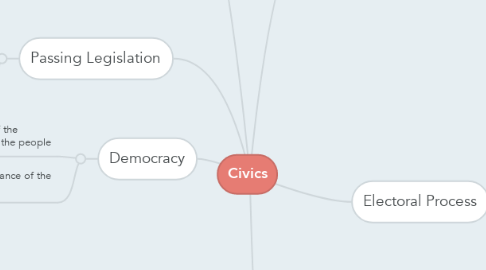
1. Political Parties
1.1. Communism
1.1.1. all property is owned by the government
1.1.2. everyone is considered equal
1.1.2.1. can become totalitarian in nature
1.1.3. ie. Communist Party of Canada
1.2. Socialism
1.2.1. a transition step from communism to capitalism
1.2.2. when the state owns the land and uses it for the better of the people
1.2.3. ie. The New Democrat Party of Canada
1.3. Liberalism
1.3.1. advocating the freedom of individuals and parliamentary systems of government
1.3.2. based on the idea that individuals have the rights and civil liberties to grow
1.3.3. ie. The Liberal Party of Canada
1.4. Conservatism
1.4.1. the idea that we should keep traditions
1.4.1.1. ie. if change is to happen, it will happen slowly
1.4.2. the best thing is established order in society and opposes radical change
1.4.3. ie. The Conservative Party of Canada
1.5. Fascism
1.5.1. government has total control, leader is a dictator and autocratic in nature
1.5.2. all opposition and criticism is surpressed
1.5.3. ie. Nazi Party of Germany
2. Democracy
2.1. refers to a soceity in which the authority of the government comes from and depends on the people
2.2. highlights the "importance of the consent of people"
3. Passing Legislation
3.1. bills go through several stages to become laws
3.2. in Canada laws originate from 1) Canadian Constitution (Constitutional Law) 2)Elected government (Statue Law) or 3) Previous legal decisions (Common Law)
4. Leadership Styles
4.1. Autocratic
4.1.1. ie. Adolf Hitler, Mao Tse Tung
4.1.2. leaders make all the decisions
4.1.2.1. good when decisions are needed to be made quickly or in a military conflict
4.1.2.2. autocratic leaders often abuse their powers and become dictators
4.2. Laissez-faire
4.2.1. ie. Warren Buffett
4.2.2. very little guidance from leaders and more freedom
4.2.3. not ideal in situations where group members have little training or knowledge
4.2.4. group member expected to solve their own problems
4.3. Democratic
4.3.1. ie. Abraham Lincoln, Wilfrid Laurier
4.3.2. everyone is encouraged to participate
4.3.3. most effective of leadership styles
4.3.3.1. leads to higher productivity
5. Canada's Political Structure
5.1. Federal
5.1.1. financial, foreign affairs, taxation, economic policy, military, government spending etc.
5.1.2. made up of the senate+the house of commons
5.2. Provincial
5.2.1. highways, police force, natural resources, education etc.
5.2.2. made up of legislative assemblies
5.3. Municipal
5.3.1. parks and recreation, libraries, recycling, public transit, sewage etc.
5.4. unlike the american system which gives, in the Fathers of the Confederation's opinion, too much power. most of the power goes to the federal governement
6. Electoral Process
6.1. the act of gaining the right to vote
6.1.1. Canada ha denied many groups the right to vote ie. women, Aboriginals
6.1.2. one of the cornerstones of democracy
